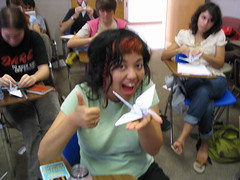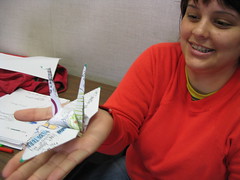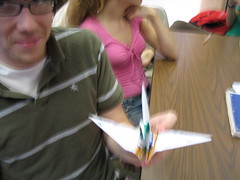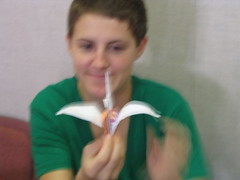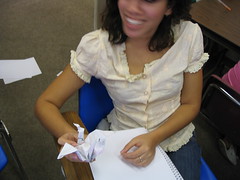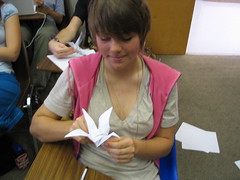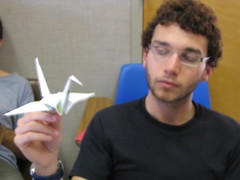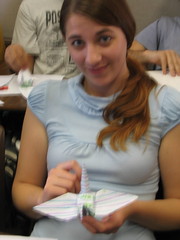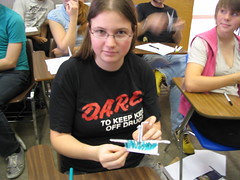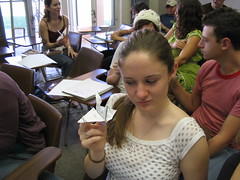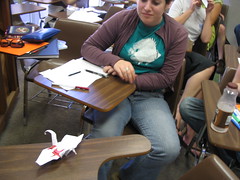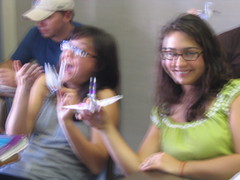Wednesday, May 16, 2007
On a Treated Victorian Novel
There's a recurring narrative if you choose to accept it as such. "Toge," something that functions as an actor in several of the pieces, provides a bit of continuity. It is impossible to deny that further continuity comes from the fact that the individual poems are all torn from the same novel. Other than that, I feel that the work is extremely scattered, and while the aleatoric nature of the book leads to meaning-slippage and cerebral high jinks, it's not for me the pinnacle of artistic enterprise.
To me, it feels as if the piece was a great idea that had to be gotten done before someone else took it. It's interesting to this end that the webpage offers newer renditions of the poems. In one way this is progressive. It provides a space for poetry that is dynamic, susceptible to change. On the other it may suggest that Phillips could have held off on publishing the work until he was completely satisfied with it.
It's rather pretentious, in my mind, that Phillips constructs phrases throughout the piece such as "now the arts connect" and "here is art" (7,8), when the mixing of visual and verbal has been prevalent since the dawn of advertising and freeform typefaces. I think A Humument is a little gimmicky for such grandiose suggestions.
My gripes aside, the piece does end up humorous at turns. These moments are for me the highest points of its success. Here, parody works and draws attention to the distinctions between the page and the reader, reevaluating inside and outside and the sacredness of the text. It seems necessary that the thing be taken lightly like that, because all told it's not that much more extraordinary than refrigerator poetry on top of blackened margins.
The Sienese Shredder
One of the most striking series of works in this anthology was the collage postcards by John Ashbery. I am not too familiar with Ashbery’s work, so I cannot speculate on the author’s intended meaning. However, the postcards do function in a particular way for me.
One of the things I noticed immediately upon looking at these postcards was the bizarre juxtapositions of incompatible objects—a free-floating heading pasted on top of a cactus, a cat head on top of a fountain, a cartoon dog next to the statue of liberty, and so forth. Many of the postcards also have anachronistic elements. For example, the last collage of the series is of a Victorian looking arm holding a wine glass pasted over an image of a rural town. This piece also draws my attention to the contrast between the civilized and uncivilized. The hand delicately grips the glass in an almost aristocratic manner, while the rural background suggests rustic naivety and simplemindedness.
Another striking piece is the one on page 139. The tension depicted in this piece is between chaos and control. An ecstatic-looking man occupies the center of piece. His expression is almost manic. His mouth is gaped, he has no shoes on and it is obvious that he is in a jumping position. He appears to be in the middle of an unfettered act of defiance. This is also supported by the fact that he is wearing a suit and is obviously engaging in deviant behavior. Beneath him are waves crashing against rocks. In the background of the top left corner of the postcard is an image of religious stained-glass windows. The religious elements suggest control, austerity, and prudishness. Conversely, the man and waves suggest chaos, disorder, and deviance.The Humument
I read the Humument cover-to-cover a while ago, but I don’t remember too many details about the content.
However, I feel that the concept of the book itself can be related to post-structuralist ideas of authorial control as well as Lacanian linguistic concepts. The post-structuralists assert that the author does not have control over the meaning of a text once it is produced. Texts function as a sort of autonomous object that can produce infinite meanings. Tom Phillips seems to be toying with this idea by taking a text and deliberately alternating in a way that produces a different meaning. By doing this he is de-centering and destabilizing meaning itself. Tom also denies the author total control of a text by using the novel to create a new text.
Similarly, Lacan thought that there was no continuity between the signifier and signified. There is always a failure of signs to achieve their proper meaning because there is no direct or innate relationship between the signifier and signifier. By altering a Victorian novel, the Humument draws our attention to the inability for the original ‘sign’ (A Human Document) to achieve its ‘proper’ meaning (the original plot of the text). The ambiguity of the Humument is also a reflection of the disconnection between signifier and signified.
A Treated Victorian Novel
The most intriguing aspect of this collection, for me, was the concept of its physical/textual transformation from nineteenth-century novel, into a modern exploration of visual poetry - primarily through means of one artist recycling another's work. In using W. H. Mallock's "A Human Document" as his base, Tom Phillips' reworking of the text is reminiscent of the inherently circular nature of creativity. And what does Phillips' reworking of the original text imply? How does it contribute to the meaning and themes of the original text? Also, the book's focus on the visual quality of each page/poem, and the way each poem conveys a different and spontaneous subject, distracts from the quality and meaning of the actual poetry. The poems are often disjointed and unclear, lacking many of the qualities prized in "good" poetry. In the abscence of impressive poetry, the detailed and vibrant images of the collection are emphasized. The images seem to be seperate from the poetry itself, lending no further imagery or illustration to the poem it encloses. Overall, I found this ambitious collection to be an interesting and visually stimulating read, but lacking in an overarching, coherent theme.
This post is actually by Rebecca Weaver....
Tuesday, May 15, 2007
A Humament.
I finally figured out how to post.
This is exciting.
I guess I should talk about Humament, which is probably the most amazing thing I've flipped through in a long while. This book helped me understand the real meaning behind visual poetry. To be honest, before reading this book, I had a hard time deciphering between "good" and "not so good" visual poetry, which is necessary to know before attempting to WRITE visual poetry. Humament defines visual poetry for me in two ways:
first, the form itself is a critique of the "word on the page," taking the most loaded and self-aware genre of writing, victorian prose, and simplifying it to "the best words in their best order," a poem. Using the empty space left after editing the text, visual art, in this case paintings, fuse the gaps between the words. Visual poetry, then, is not poetry with words, it is the written word combined with visuals as one complete art form.
Secondly, what makes Humament so integral in my understanding of visual poetry is the fact that if needed, these poems could stand alone without the visuals. I understand visual poetry as poetry ENHANCED by visuals, and hopefully not the other way around. What I have categorized as "bad" or less well crafted visual poetry seems to consist of kitchy objects simply decorated with words.
I guess to summarize, the difference between good and not so well crafted vis. poetry lies in the difference between creative and cleaver art. Humament is of course, the former.
=)
SaM.
Tuesday, May 8, 2007
Humument: I have already posted this, but just in case you haven't seen
I found the artwork fitting in some cases and empty in others, but I think it was the variation of style that caught me. The artwork either echoed the themes of the poetry on the page or stood silent to let the words speak for themselves. Pleasing to the eye, but rarely as stimulating as some of the poetry.
Overall, when I first laid my hands on the book I was excited. It had the guise of the masterpiece I had been waiting for all my life because it is tediously creative and beautiful. But with a second and third glance through it’s glossy pages, I began to understand it more for its purpose which I believe (sorta) to be, rewriting history in a politically, socially, climactic time as the 1970s. Stenciling over the Victorian age itself with a breathe of ingenuity and fantastic art in most of it’s pages.
Sienese Shedder: Hammond
Thursday, April 26, 2007
This book was indeed a sort of cut-and-paste accumulation of art, prose and poetry. Some pieces, like the Osap's Fables, seem at first glance to be completely nonsensical, while others seem to follow thought patterns. The shorter prose paragraphs often fell lyrically upon the ear enough for me to consider them poetry, and in fact often seemed to debate this fact within themselves. I actually found that my favorite piece wasn't one of the cut-up bits that give the Shredder it's unique internal look, but was actually one of the first pieces that falls into the 'prose' category. Gerard de Nerval's Chantilly is an expression of a place, a snapshot almost. The author gives to us his reminiscence about a place he obviously loves, from visual impressions to the memories they inspire, the character of which infinitely colors the impression of the place. Much like Chantilly lace he lays out the places and customs as you might excpect, and then he drops in the harshness of reality, deaths and sorrow that bring the rosy quality of the memories to a much deeper and more soulful hue. This piece is an exceptional example of what I feel gives way to the always present question, what is poetry?
Monday, April 16, 2007
Ghost Dad was an exceptional movie.
I also liked Edwin Denby's poem about the "no-nonsense escalator." See, I'm scared of escalator's because my Grandma was a scary person that told me really nonsensical things about ordinary everyday objects that transformed them, in my mind, into monstrosities. The escalator was one of them. And I am sure plenty of other kids can admit to being horrified by the story about the boy whose foot got stuck in the escalator. I mean, it's a traumatizing thing when you're seven years old. So I think the poem really hit a reminiscent spot for me which helped me to identify with it and ultimately cherish it.
Actually, I really liked all of The Sienese Shredder. Even the boring parts were more exciting than reading the usual monotony that people read in things like Time magazine everyday. And there was just something about the journal, beyond the entries, just a general feel about it I guess you could say, that really seemed to resonate with me. I felt like it's a journal that represents a new chapter in the life of art, a chapter that I get to be experiencing first hand, and as cheesy as that may sound, I'm not going to lie; I'm excited.
Tuesday, March 27, 2007
Chocolate bar between two slices of bread--
words know how to find their own way
and, left to themselves, decide where to land." -- Marie Chaix
The Sienese Shredder collectively reflect Chaix's principle. She illustrates by narration alone the flexibility of language as universal enough to transcend convention, while John Ashbery and Jane Hammond manipulate images and scarce text in order to conceptually test the limits of this flexibility.
While most of the book's entries challenge my rejection of language as mere iconology, poets Jane Hammond, Ron Padgett and Chris Edgar reinforce it. I inherently classify poetry, however narrowly, as an art most heavily dependent on its language -- the way they're arranged on the page or stressed vocally. I suppose more innovative means of presenting a poetic idea or story allow for a wider range of interpretations (and isn't personalized catharsis art's goal?)... but visual poetry like Ashbery's and Hammond's, when presented alongside more conventional free verse poems, seem to contain messages too far removed from the artist's original emotional intent.
Wednesday, March 21, 2007
Strange, Strange Sienese Shredder
My favorite piece (besides, of course, our dear Carbo’s :P), is Ron Padgett’s “The Absolutely Huge and Incredible Injustice in the World,” a nouveau work humorously outlining the irony of the unjust and inescapable disposition of mankind. He juxtaposes genuine inquiries and proclamations of human nature, such as “What makes us so mean?,” “It is hard not to be appalled by existence,” and “Life is so awful!” with amusing images of gorillas, hippos, and other oddities, overly dramatic ejaculations, and arbitrary tangents. In doing so, Padgett quite effectively lends a sense of outlandish humor to what could have been a drearily serious work.
Another choice example is, in my opinion, Harry Mathews’s “Romantic Poem,” which, barring the title, would not leave any notion of romantics. I enjoy how the title adds a new dimension to the poem and forces the reader to search for hidden meanings between lines.
All that said, I totally want to kidnap the puppy pictured on the postcard on page 144. How cute can you get? :)
I have a face that stays mostly on the front of my head
The New Crustacean
A warning is offered right at the offset that concrete subjects will be problematic throughout the text. The narrator states that he (“a father, a brother, a lover, a friend”) cannot tell about himself because “you’d only be further from the truth.” He sets up the technique that will dominate the rest of the text by stating that he is “determined entirely by context.” The reader learns that he has a family, a past, and at the end he hitches a ride toward an indeterminate future, but the details are not offered. In one instance, no circumstances are disclosed of an event which overtakes the narrator with nausea and pain. All that exists are the peripheries and consequences, and the reader is left to imagine endless possibilities that could assume the event.
The most striking example of this occurs when the narrator prepares himself to return to the site of a family camping trip. The site is not described, but simply by its being an attraction because of its lake, vivid images which must differ from reader to reader cascade through its absence. The same is true of whatever objects a clerk at the “large store” advises the narrator to bring along. He sheepishly purchases four of something we can almost picture clearly: fishing lures, boots, ponchos, meals-ready-to-eat, rifles, snake bite kits, compasses, styrofoam floaties, etc.
The commentary on how stories can exist with such absences suggests that ingrained in readers are types of narrative frameworks which stand nearly by themselves. In reflecting on “The New Crustacean,” it is hard not to think of Saussure and the structures of difference which make language possible. Per the theory of his successors, these structures stand as well without centers. By constructing walls such as the one where Hasegawa’s narrator purchases the unnamed supplies, the author creates empty spaces for images, the specificity of which are unimportant.
Cool
Yet the books seems focused not on compartmentalizing or particularizing these contributors as much as it wishes to reveal their coalescence, discussion, and interest in one another.
It seems that Sienese Shredder is interested in poetry that is infested in and contributing to the world of visual arts, as well as revealing the sort of inverted or surprising discussions of art--such as the interview by Judith Stein wherein Richard Tuttle is interviewed about an art dealer. Instead of reading about the artist (Tuttle) we're reading a behind the scenes; stories about the people to whom the art is made collectible. Suddenly the person supporting art is given representation.
I also thought it was also interesting that the book was edited by two painters—Brice Brown & Trevor Winkfield. Furthermore, Sienese Shredder includes visual peices by John Ashbery. His long interest in Dada and Surrealism as well as his proliferation of art & poetic critique are no where to be found, instead we get only images he's produced.
It seems to be a re-examination and perhaps a revitalizationg of the New York School, the practices and interests of this school, and the ongoing transformation and transmutation of experimental poetry within art and aesthetic practices more generally.
Also, I was also thinking about the title and this is what I came up with:
Sienese = Sienna – during the 14th and 13th centuries was the center of a flourishing school of art
Shredder = a machine or other device used for shredding something.
So, yeah, I think that is an appropriate title.
Sienese Shredder as kooky
One piece I was especially interested in was Francis M. Naumann's attempt at solving Marcel Duchamp's unsolvable chess problem Opposition and Sister Squares are Reconciled [1932]. (It’s weird to think of Duchamp taking a hiatus from art to practicing his extreme chess master skills.) I looked the nature of this essay up on the internet and it said: Opposition and Sister Squares are Reconciled deals with endgame theory in chess specifically analyzing positions in which only kings and pawns remain, including the incredibly rare and even more obscure Lasker-Reichelm position. The Lasker-Reichelm is a position in which both kings are still free to move and white has 4 pawns all blocked – unable to move – by black’s three pawns. Those are all the pieces on the board and – from what I have been able to carefully gather – black can only hope for a draw and, given competent play, can produce one all the time.
I think it’s interesting to explore the process of chess as one would explore the process of art rather than looking to win or solely at the product/piece. This process of creating and the perspectives and possibilities this opens up to the viewer seems to be a prevalent theme in this collection from the Carbo's poem to the ghost weave.
Tuesday, March 20, 2007
Wednesday, February 28, 2007
Hmmm.
Sorry.
Tuesday, February 27, 2007
I found "A Humument" to be surprisingly engaging, as traditional forms of peotry are abandoned and rather than meter, rhyme and structure creating a flow to the language, the active pull of the visualization of a complete poem on a scattered page of words is what pulls you through the work. As I was reading the book at first, I observed what seemed to be a poem about the act of making poetry, and then seemed to be about the associations of love with poetry. As I got further and discovered the implication of a narrative, I discovered that what I was reading was the personal expressions of the author on and about the creation of poetry through himself and the character 'toge', who is both the creation of his poetry and also a representation of himself. The narrative, if that's what you can call it, vaguely follows a poetically inclined life through it's ups and downs and the kinds of life experiences thet engendre poetry in the first place. In the style of the epic, each page is a snapshot of a moment, or an experience, or a feeling that could not be expressed. Also much like an epic, as the book moves further on the author brings in other characters who are captured in the midst of their experiences of life in the pages of his book, and every person experiences life differently so he brings new colors and tones into his poetry as he adds new (or old) characters, both in a literary and a perfectly literal sense made possible by the visual execution of the work.
The poetry also makes me curious about the book, as while the poetry does not follow the characters of "A Human Document", it very obviously follows the emotional tone of the book, given the useable repetitions of words that appear in the poetry. The language that we use is part of how one creates a mood in a poem or a book, and the author is using the language that was already available, which leaves me inclined to believe that he read the Victorian novel as it was written and saw the potential for something else hidden in it's pages. The book as it has been presented to us appears to be about the evolution of poetry through life and conversly the expression of life as poetry. "I am sad and so I write poetry, but also I am sad and that in and of itself is poetry", the true poet sees poetry everywhere. It is a poetical expression of life, love, art, the travails of the writer, the pain in the world that makes beauty beautiful, and the fluidity of all things as life and experiences overlap to form systems of ups and downs that our classically trained minds experience as poetry and art. The visual aspect is facinating as he uses it for stops, pauses, tone, and the almost forceful dragging of the reader through the book much as one lyrically trickles through a Frost poem. Given the disconnected and haphazard word placement on the pages, the art is also like a guide, and is the only reason the poetry makes sense.
I quite liked it. It was like a playground for my brain.
Saturday, February 24, 2007
Wednesday, February 21, 2007
A Humument
As we continue jump to dynamic ideas, the title begins to support the general presence of the text as the reflection fo a human being in all of his scattered details. Yet the visual proves a little distracting in its chaos. On many pages atterns and shapes are haphazardly arranged despite the lack of any visual connection to the poems. Some of the pictures bring to mind the doodles the appear through an anxious state of boredom, or as a means of destraction from the task at hand.
However, Tom Phillips may consciously be undermining man's sincerity that sporaticaly appears through A Humument. This could prove to be a successful literary tool if only the character were defined more or if the images were more consistently adolescent. Overall the scattered visual and poetic elements reveal a dominanting feature in the human conscious with a tone of sarcastic belittlement, to me.
Tuesday, February 20, 2007
The Humument
As far as issues of narrative within The Humument go, there seems to be a very vague narrative, or at least a series of connected ideas. While there are a few characters that pop in and out of the book and each page has some bearing on the ones before and after it, there isn’t what could be traditionally considered a story. This, in part, is where it seems to be most poetic. The abstraction of the narrative and the events happening in whatever narrative there is can be attributed to The Humument’s poetics.
Also of note is the attention given to The Humument’s visual component. The visuals on each page seem to be more carefully considered than any of the traditionally poetic elements of it (i.e. word choice). This brings up concerns over the correlation of any visual element of a page to the particular words chosen to be singled on the page. The visuals on each page are notably distinct from the visuals on the other pages and seem to be set up to distinctly relate to the words chosen on the particular page. For instance, a page in which abstract art is mentioned, a representation of abstract art is presented on the page.
Notable is page 73 on which there appears to be relatively no visual element to the poetics of the page, although if one looks close, Tom Phillips has cut up and mixed up words to describe a particular sex scene and make a lot of sex jokes. Within the context of the work as a whole, this seems to work really well since it draws attention to itself as a piece of text rather than having a very important visual element to it. When one reads the actual text on the page, it’s really funny with various “ughs” inserted throughout the text and words cut up to be assembled into the words “cock tease”. Since the actual text on the page is meant to be considered as a whole, the choice to not include any immediately visible visual manipulation seems to be a wise one.
Thursday, February 15, 2007
Wednesday, February 14, 2007
Humument
The primary themes evident throughout this text are those of erotic impressions (my favorite occurs on page 244, on which the text “ceaseless sliding tower burnished piston-rising and falling, fully the perfect skill of man” appears in the forefront of a not-so-subtle phallic “tower”), a certain “Toge” and his struggle with coalescing the struggles of love with the joys of art, connections to “Irma,” and expressions of creativity. The reoccurrence of these themes formed what I found to be a sort of false narrative. While there is a roundabout way to follow the subjects and ideas throughout the text, any direct proclamation of a storyline is, to me, incorrect.
I believe the main conflict within this work was that of how to express creativity. Is it through love, as is insinuated periodically, or is it best portrayed in art or poetry? By combining expressions of all three in this text, the author effectively conveyed this conflict, meaning the art ultimately added to the story.
Tuesday, February 13, 2007
The book reminded me of a comic strip in the way that they both use the idea of a polyptych. The main difference being that the understanding one can gain from viewing the pictures of a comic alone is much greater than that gained from viewing the visuals of Humument. I've drawn the conclusion that the only way I feel comfortable talking about the book at this point is in relation to other things.
Humument
When one goes to read a novel they are expected to go progressively page by page. When one reads a poetry anthology the form suggests the possibility of an important for reading order but this isn’t always necessary. Reading an artists monograph is different as well. The images stand coherently on there own and can be addressed individually as well as in different orders. With the considerations of how an audience approaches different forms it is interesting to think about how the form of a book dictates how it is read. From this inquiry one can then address the question of narrative.
I first approached the book as a novel. There seemed to be a sort of narrative and maybe a romantic interaction between two character. I also read a large portion of the book out of order. Many of the pages seemed to stand of the context of others. This approach is helped by the visuals with stand very distinctly from one an other as opposed to sequential design/cartoons.
Do the visuals distract?
Having said that the form of the book yields different meanings depending on the interpretation of its form, the visuals steer the viewers to addressing pages as individual pieces. The visual aspect of the book as well as the form of the text makes the order puzzling as well. But the order, meaning, and interpretation of certain pages is guided by the visuals.
More importantly than the factor of the narrative I find it interesting that the author/artist is critiquing the layers of meaning possible within art/literature. The work functions off of a variety of levels: language, novel, poem, picture, and the increasing editing of the work itself. It is interesting to acknowledge each layer as well as there interplay.



















